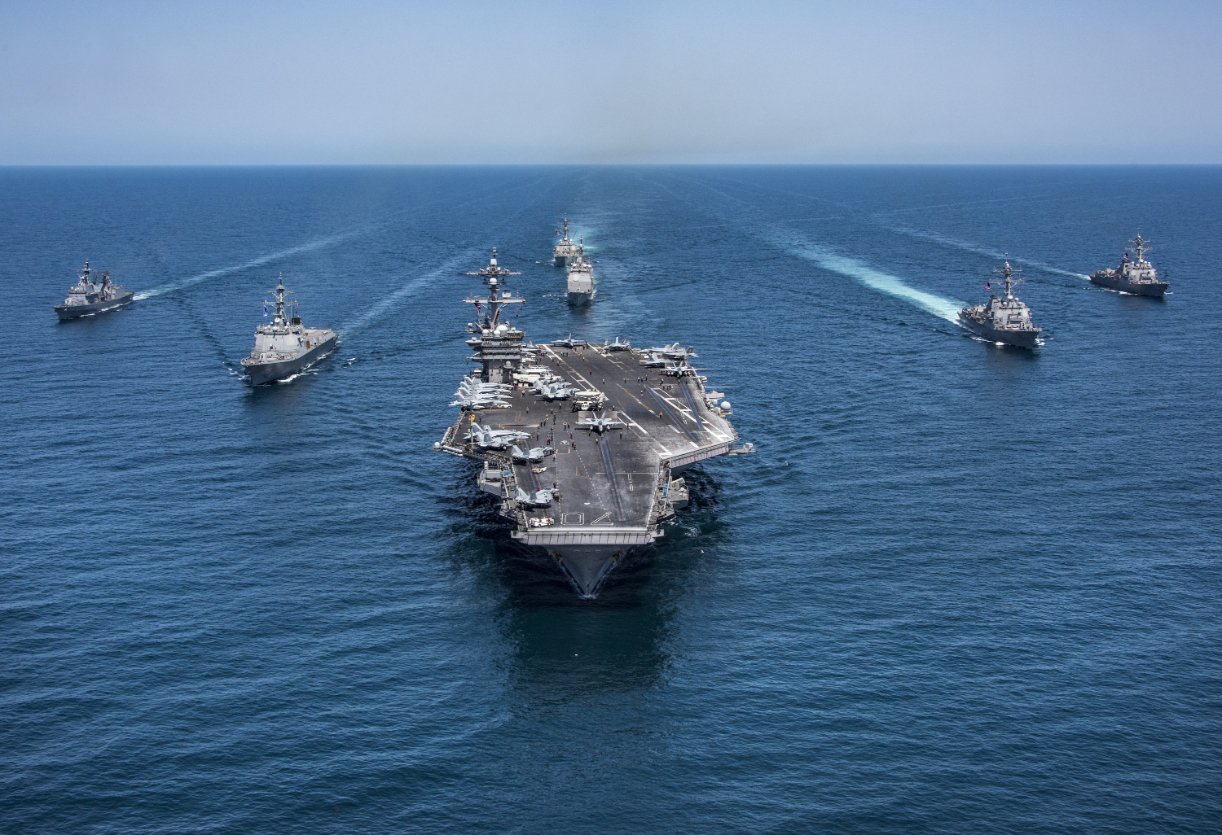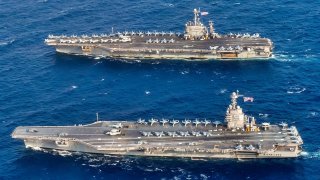The Navy's Legendary Nimitz-Class Aircraft Carriers Could Get 'Extended'
Until the Ford-class aircraft carriers enter service with the U.S. Navy, the extended life spans of the existing Nimitz-class carriers will be essential to preserving America’s maritime security strategy.
Nimitz-class aircraft carriers could all get extended lives: The U.S. Navy’s Nimitz-class aircraft carriers may be turning 50 soon, but that doesn’t mean they will be relegated to retirement shortly thereafter.
Considering the demand for the carrier air wing amidst rising global tensions plus delays to the Nimitz-class replacement, these aging ships are bound for a longer than expected service life.
Last month, Aviation Week reported that the Navy’s fiscal 2023 budget includes the extension of the in-class CVN-68 for an additional deployment cycle rather than be decommissioned in 2025 as previously intended.
Due to this change of plans, analysts predict that the next ship in the class, the USS Dwight D. Eisenhower, could also be granted a service extension.
Does the Nimitz-class beat Father Time?
To lengthen the Nimitz-class carrier's service lives, the Navy will invest roughly $200 million during a five-and-a-half-month maintenance period. While this number may seem hefty, the consistent presence of U.S. carriers is abundantly important.
The Navy recently deployed two of its carrier strike groups to the eastern Mediterranean and the Persian Gulf to deter Hezbollah and other Iranian-backed groups from expanding the ongoing Israel-Hamas War.
As tensions between Washington and Beijing continue to mount and Moscow shows no signs of backing down from its nearly two-year-long invasion of Ukraine, the U.S. Navy’s prowess will remain critical.
Introducing the Nimitz-class aircraft carriers:
The Nimitz-class ships were initially conceptualized to supplement the Navy’s older carriers like the Kitty Hawk, Forrestal and Enterprise classes.
Equipped with nuclear two reactors, the Nimitz-class carriers take up far less space than the eight reactors needed to power the Enterprise-class. Nimitz ships can also lug up to 90% more aviation fuel and 50% more ordnance compared to its predecessors.

Since the initial design of the Nimitz coincided with the start of the Vietnam War, some aspects of the Navy’s struggles in this conflict influenced the carrier class.
Specifically, the carrier operations throughout the Vietnam War indicted that enhanced capabilities incorporated onto carriers would increase their survivability.
A history of the Nimitz carriers:
Additionally, the Nimitz-class ships were designed to lead the Navy during the Cold War. Powered by nuclear sources instead of oil allowed for greater endurance and the ability to adjust weapons systems onboard.
While the premiere ships in this class were classified as attack carriers, later models were constructed with anti-submarine capabilities. The USS Nimitzis the lead ship of the carrier class, named to honor a former Naval admiral who fought during the Second World War.
Over the years, 10 Nimitz ships were built, with the final of the class being USS George H.W. Bush, which was commissioned in 2009. Each ship in this class can carry roughly 60 airframes, including an array of rotary-wing and fixed-wing aircraft with up to 90 different types.
Perhaps the most significant improvement incorporated on the Nimitz carriers is the cutting-edge GPS-enabled aircraft carrier landing system dubbed the Joint Precision Approach and Landing System.
This technology eases landing and taking off for pilots, which can be challenging to perform on a small, moving runway easily hampered by poor weather and sea conditions. JPALs were introduced as part of a series of improvements built into the Nimitz ships to better prepare for the arrival of the fifth-generation F-35 Lightening II fighter jets.
What About the Ford-class aircraft carriers?
While the Nimitz-class is widely considered to represent some of the best aircraft carriers in the seas today, its successor, the Ford-class, is designed to be even more advanced.
To date, however, only one Ford-class ship has been commissioned - the namesake Gerald R. Ford. The Ford was projected to cost around $10.5 billion, but ultimately, the ship cost the Navy $13.3 billion, making it the most expensive warship ever constructed. The second Ford-class carrier is the future USS John F. Kennedy. Although the ship is fitting out, it isn’t set to be commissioned into service until 2025, which could then be followed by lengthy sea trials.
Until the Ford-class ships enter service with the Navy, the extended life spans of the existing Nimitz-class carriers will be essential to preserving America’s maritime security strategy.
Maya Carlin is an analyst with the Center for Security Policy and a former Anna Sobol Levy Fellow at IDC Herzliya in Israel. She has by-lines in many publications, including The National Interest, Jerusalem Post, and Times of Israel. You can follow her on Twitter: @MayaCarlin.
All images are Shutterstock.


